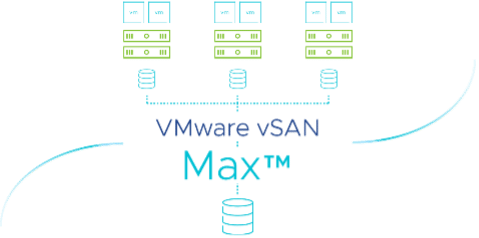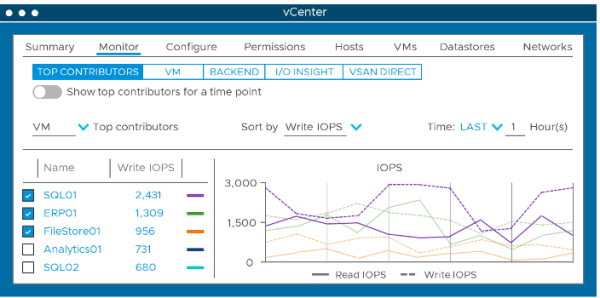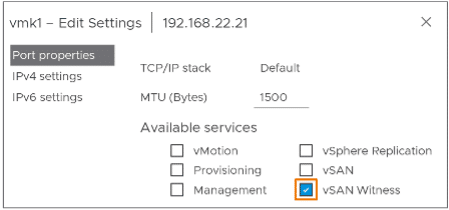Keeping with the commitment to support customers’ critical workloads, VMware announced the upcoming release of vSAN 8 Update 2 and, during VMware Explore in Las Vegas, introduced VMware vSAN Max, a new, optional disaggregated storage deployment model built on vSAN Express Storage Architecture (ESA). Customers running vSAN 8 U2 can expect up to 30 percent improvement in overall performance gained through multiple platform enhancements.
Keeping with the commitment to support customers’ critical workloads, VMware announced the upcoming release of vSAN 8 Update 2 and, during VMware Explore in Las Vegas, introduced VMware vSAN Max, a new, optional disaggregated storage deployment model built on vSAN Express Storage Architecture (ESA). Customers running vSAN 8 U2 can expect up to 30 percent improvement in overall performance gained through multiple platform enhancements.
vSAN Max Delivers Petabyte-scale Disaggregated Storage for vSphere
vSAN Max, powered by vSAN Express Storage Architecture, is a new offering within the vSAN family. vSAN Max is an optional deployment model that delivers petabyte-scale disaggregated storage for vSphere. With vSAN Max, users can scale storage independently from compute, offering more flexibility to support workloads.

This new storage solution promises to offer exceptional performance and scalability, allowing companies to manage large workloads and data volumes while maintaining high efficiency and speed. It’s a groundbreaking solution that ushers in a new era of enterprise storage capabilities.
In addition to the new vSAN Max offering, enhancements across vSAN Express Storage Architecture will deliver improved performance, while new functionality in the vSAN platform will continue to improve daily operations and user experience. vSAN Max will be licensed separately from existing vSAN editions and offered as a subscription with licensing based on a per tebibyte metric.
VMware vSAN Max Offers Choices to Maximize Resources
Organizations rely on various applications to effectively operate their businesses. These applications encompass varying compute power, storage capacity, and performance prerequisites. The utilization of advanced analytics, AI applications, and cloud-native solutions is steadily increasing, while fundamental elements like relational databases and virtual desktops remain indispensable. The evolving assortment of workloads, coupled with dynamic scaling requirements, has drawn attention to the necessity for a flexible infrastructure that can keep up with the scaling needs of these mission-critical applications as business demands.
Leveraging vSAN Max, users can scale storage independently from compute for added flexibility to support all of their workloads. Built utilizing the vSAN Express Storage Architecture (ESA), vSAN Max introduces benefits for those seeking to swiftly expand storage capacity with heightened levels of performance and resilience. The standout feature of vSAN Max lies in its ability to offer impressive scalability and enhanced cost efficiency. This notably boosts the value proposition for executing storage-intensive workloads on Hyperconverged Infrastructure (HCI) setups. By optimizing resource allocation and trimming down the Total Cost of Ownership (TCO) by potentially up to 30 percent, vSAN Max proves to be a compelling asset.
The flexibility of vSAN Max is represented by its capability for scaling out and scaling up. Customers are granted full autonomy in augmenting capacity according to their needs. vSAN Max nodes offer up to seven times the density of HCI nodes and can scale out to encompass over 8.5 petabytes within a cluster. The scope of scalability extends to performance, considering each node added to a vSAN Max cluster bolsters the available performance. Given that vSAN Max is built on the vSAN Express Storage Architecture, it accommodates substantial datasets. It adheres to rigorous performance and resiliency standards, boasting up to 3.6 million IOPS per storage cluster.
A hallmark of vSAN, the ability to manage all environments—both the conventional HCI model and the disaggregated model—through a single interface remains steadfastly in place. This offers customers a unified management approach, facilitating efficient control over their diverse environments.
vSAN 8 Update 2 Integrates File Services With ESA
vSAN 8 Update 2 introduces the integration of vSAN file services with the Express Storage Architecture (ESA). This enhancement offers customers the advantage of leveraging the performance and efficiency benefits of vSAN ESA for environments utilizing vSAN file services. All the functionalities available in vSAN file services under the original storage architecture (OSA) in earlier versions of vSAN will now be extended to vSAN file services on the ESA. This includes enhanced space efficiency, improved performance, and creating smaller failure domains.
With the release of vSAN 8 Update 1, VMware introduced a new and innovative method for managing write operations within a storage architecture. This feature will enhance the performance of workloads that involve a substantial volume of writes or highly sequential write operations by employing an optimized approach. This improvement is now extended to disaggregated topologies in vSAN 8 Update 2 with the introduction of vSAN Max. Consequently, virtual machines (VMs) operating within a vSphere or vSAN cluster, while utilizing the storage resources of another vSAN ESA cluster or vSAN Max cluster, can now benefit from this advanced capability.
vSAN ESA ReadyNode Designed for Small Data Centers and Edge
vSAN 8 Update 2 brings two notable enhancements, giving customers greater flexibility when considering using vSAN ESA. First up, a new ReadyNode profile is introduced, catering specifically to small data centers and edge environments. This profile, designated AF-0 ReadyNode, entails lower hardware requirements, including 10Gb NICs, allowing customers in such environments to harness the benefits of vSAN ESA without needing the high performance offered by other, higher ReadyNode profiles.
Second, vSAN 8 U2 introduces support for lower-endurance “Read-Intensive” storage devices. These storage devices are designed to handle less intensive input/output (I/O) workloads. They can be employed across various ReadyNode profiles, providing a more cost-effective solution for environments where applications do not exert heavy I/O demands. This expansion of hardware options offers a better pricing point for deployments with less I/O-intensive applications.
Streamlined Management
All the new enhancements, like performance, resilience, and flexibility, mean little if a solution is not easy to operate. The update to vSAN 8 offers several new improvements to simplify the day-to-day operations of administrators, streamline issue detection, and accelerate time to resolution.
The vSAN 8 Update 1 introduced a new Auto-Policy Management feature to aid administrators in configuring their vSAN ESA clusters with optimal levels of resilience and efficiency. With vSAN 8 Update 2, following the addition or removal of a host from an existing cluster, the Auto-Policy Management feature evaluates whether the optimized default storage policy requires adjustment. If a change is necessary, vSAN can modify the affected storage policy through a simple button in the triggered health finding. This action starts reconfiguring the cluster-specific default storage policy with the newly optimized policy settings.
Furthermore, vSAN 8 Update 2 improves the clarity of cluster capacity reporting. A new category named “ESA object overhead” is introduced in the “Usage breakdown” section of the cluster capacity dashboard. This category reports the overheads of processing and storing data through vSAN ESA’s log-structured filesystem (vSAN LFS). This enhancement aids administrators in accurately determining the capacity consumption overheads within their storage system.
The update also brings enhanced storage device management at scale. A new capability within vSAN ESA allows administrators to define a standardized disk-claiming outcome for the hosts forming a cluster. vSAN then attempts to apply this desired configuration across all hosts in the cluster. If the configuration cannot be applied, a health finding is triggered in Skyline Health for vSAN. This new vSAN ESA prescriptive disk claim feature builds upon vSAN ESA’s capacity to deliver high performance while remaining user-friendly.
In response to the increasing sophistication of security capabilities in infrastructure, vSAN now supports the use of Key Management Service (KMS) servers that incorporate a “key expiration” attribute for assigning an expiration date to a Key Encryption Key (KEK). An integration with Skyline Health for vSAN triggers a health finding report as KEK expirations approach, simplifying management tasks.
Optimal Configuration is Simplified with Default Policy Intelligence
In vSAN 8 Update 1, a new Auto-Policy Management feature was introduced to assist administrators in configuring new vSAN ESA clusters to achieve optimal levels of resilience and efficiency. vSAN 8 Update 2 further enhances this feature. When a host is added to or removed from an existing cluster, the Auto-Policy Management feature evaluates whether adjustments are needed for the optimized default storage policy. If vSAN determines the need for a change, it can modify the relevant storage policy through a simple button within the triggered health finding. This action triggers reconfiguring the default storage policy specific to the cluster with the newly optimized settings.
Furthermore, vSAN 8 Update 2 improves the clarity of cluster capacity reporting. A new category labeled “ESA object overhead” is introduced within the “Usage breakdown” section of the cluster capacity dashboard. This category reports the overheads of processing and storing data through vSAN ESA’s log-structured filesystem (vSAN LFS). This enhancement aids administrators in more accurately determining the overheads associated with capacity consumption in their storage system.
Advancements in Storage Device Management
The update introduces advancements in storage device management at scale. An innovative capability within vSAN ESA enables administrators to define a standardized disk-claiming outcome for the hosts forming a cluster. vSAN then attempts to apply this desired configuration across all hosts in the cluster. If the configuration cannot be applied, a health finding in Skyline Health for vSAN is triggered. This new vSAN ESA prescriptive disk claim feature builds upon vSAN ESA’s ability to deliver high performance while remaining user-friendly.
Addressing the evolving sophistication of security capabilities in infrastructure, vSAN 8 Update 2 supports the use of Key Management Service (KMS) servers that incorporate a “key expiration” attribute for assigning an expiration date to a Key Encryption Key (KEK). An integration with Skyline Health for vSAN triggers a health finding report as KEK expirations approach, simplifying management tasks.
In addition, the update enhances the intuitive detection of VMs and disks consuming the most resources through the Top Contributors view, initially introduced in vSAN 7 Update 2. In vSAN 8 Update 2, the improvement to this tool helps customers identify performance hotspots not just for specific points in time but across customizable timeframes. Now, administrators can assess other top contributors within the same performance view, whether related to IOPS, throughput, or latency. This enhancement means quicker evaluation of VMs that place the highest demand on the cluster’s resources, aiding in identifying potential resource imbalances.
vSAN U2 enhances the detection of performance bottlenecks in stretched clusters through the vSAN I/O Trip Analyzer. This tool can now analyze workloads within a vSAN stretched cluster, allowing users to easily determine the primary source of latency within the cluster and latencies in other parts of the stack contributing to the overall latency experienced by the virtual machine.
Making configuration easier, vSAN 8 Update 2 simplifies the setup of stretched clusters and 2-node topologies. Customers can tag vSAN witness traffic in the witness host appliance via VMkernel configuration settings, eliminating the need for command line tagging of witness host appliance traffic. Additionally, the update introduces expanded witness host appliance sizes available for vSAN ESA, including the “medium” sized witness host appliance alongside the existing “large” size. This new medium-sized witness host appliance, consuming two vCPUs and 16GB of RAM, supports up to 500 virtual machines.
Engage with StorageReview
Newsletter | YouTube | Podcast iTunes/Spotify | Instagram | Twitter | TikTok | RSS Feed



